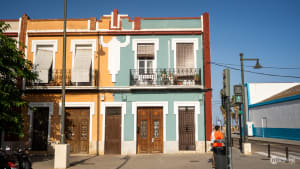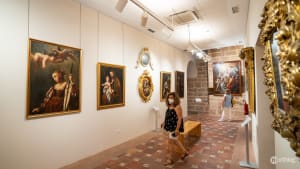
Top Gothic Jewels in Valencia
Pointed arches, spiralling staircases, stained windows, and gargoyles. These are the architectural features that populate the many Gothic landmarks in Valencia.
Gothic Jewels in Valencia in a nutshell...
Valencia’s Old Town showcases Mediterranean Gothic architecture characterized by bright spaces, tall pillars, pointed arches, and plant-motif stone decorations.
Key monuments include the 15th-century Lonja de la Seda (Silk Exchange) with its intricate carvings, the medieval Quart and Serranos Towers (the city’s only remaining fortified gateways), and the Cathedral with its Gothic elements and Miguelete bell tower.
Other Gothic treasures include San Agustín Church with its pointed windows, the Palacio de la Generalitat Valenciana featuring a Gothic façade and floating stairway, Santo Domingo convent with its palm-like ceiling arches, and San Juan del Hospital, Valencia’s first post-Reconquista church with Europe’s only Cistercian Gothic chapel.
Valencia is known for its abundance of Gothic buildings, especially in the Old Town, the city’s historical centre. Here, at every corner you turn, you’ll find beautiful Mediaeval architecture and ancient complexes. But if you want to wander around with a little more aim, here are our recommendations for the most important Gothic jewels in the city.
The Gothic style found in Valencia is known as Mediterranean or Southern Gothic. This is because this style arrived here later than in other European countries. Consequently, it presents some peculiar characteristics.
Valencian Gothic is known for its open and bright spaces, its firm vertical elevation, tall pillars, long, stained-glass windows, and different types of pointed arches. Stone sculpting is used to decorate buildings, with reliefs often depicting local plant motifs.
There are several churches and civil buildings in Valencia that fall under the definition of Gothic in some way or another. However, many of them also present a variety of other styles, which often overpower the Gothic essence of the structure, like the beautiful Saint Nicholas Church.
But here we have gathered all the buildings that most clearly reflect the typical Valencian Gothic style, both in its structure and in its decorations.
Lonja de la Seda
The Lonja de la Seda (Silk Exchange, in English), built in the 15th century, is perhaps the most important example of Valencian civil Gothic style.

Its structure is a triumph of elongated and evocative lines, intricate shapes and decorations, allegorical carvings and bas-reliefs. Stepping into the building feels like walking into a high historical fantasy dream. Tall and painstakingly decorated with coffered ceilings and pointed arches, the halls of this Valencian gem are populated by mysterious, demonic stone figures.
Quart and Serranos Towers
You’ll find these two Gothic treasures in the Carme neighbourhood, at its northern and western edges. Once part of the twelve entrance points along the fortified wall, the Quart and Serranos Towers are the only two remaining gateways in the city.

The Torres are a must-see for anyone who wants to get an idea of the Valencian Gothic style. In both towers, the sides facing the city’s Old Town clearly show the different levels through large arched openings. All the chambers have vaulted ceilings, whose ribs rest on corbels often decorated with floral themes.

The Serranos Towers present a unique blend of military and ceremonial architecture, complete with decorative panels, gargoyles, and blind arches. The Quart Towers, on the other hand, are more strictly military and less decorated, but unmistakably Gothic nonetheless.
Catedral de Valencia and Miguelete
The Cathedral of Valencia (also called la Seu) is Valencia’s most important religious building and the place where you can find the Holy Grail, as recognised by the Roman Catholic Church. The building underwent several remodellings, so it presents a variety of styles and influences.

However, the mark that the Gothic style left on the building is unmissable, especially on the exterior structure and floor plant. One of the Cathedral’s main doors, the Puerta de los Apóstoles, is an excellent display of French Gothic style.
Inside, the space has a fairly open and horizontal appearance, typical of Valencian Gothic architecture. The main nave and chapels also bear these characteristics. Another jewel of the same style you don’t want to miss is the Miguelete, the Cathedral’s panoramic bell tower.
Parroquia de Santa Catalina y San Agustín
The Parish Church of Santa Catalina y San Agustín, commonly known as San Agustín Church is located at the southern edge of Valencia’s Old Town. The complex, built in the 13th century in Valencian Gothic, received some Barroque additions later on in the 17th century.

The church’s approach to the Gothic style is a particularly light and bright one, thanks to the large pointed windows in the presbytery and the arcades along the cloister.
Palacio de la Generalitat Valenciana
Overlooking Plaça de la Mare de Déu, the Palacio de la Generalitat Valenciana is a 15th-century building that has acted as the headquarters of many governmental institutions, and now houses the Generalitat Valenciana.

The architecture of this beautiful palace is a complex mixture of Valencian Gothic style and various Renaissance interventions. The façade and the main structure, with its open courtyard and its floating stairway, are clearly Gothic.
Other elements in the same style are the pointed door on the mezzanine and the tri-lobed windows. The palace is also accompanied by a beautiful orange-tree patio, typically Valencian.
Convent of Santo Domingo
The construction of the Santo Domingo convent began in the 13th century and continued for hundreds of years after that. While the façade, some chapels, and the cloister are Renaissance, Baroque or Neoclassical in style, the Capilla de los Reyes and Aula Capitular are visibly Gothic.

In a brilliant example of the Valencian variant of this style, the ceilings are crisscrossed by dramatic buttresses and arches and sustained by slender columns. These open up to the ceiling in palm-like shapes and are said to be the inspiration behind the famous Sala de Contratación in the Lonja de la Seda.
San Juan del Hospital Church and Cemetery
Built around 1261, San Juan del Hospital is believed to be the first church built right after the Christian Reconquista. As such it bears much more of a Cistercian imprint (a sort of transitional stage between Romanesque and Gothic style) rather than a Baroque, Neoclassical, or Renaissance one.

Particularly noteworthy is the Mediaeval Cemetery, located in San Juan’s southern courtyard. The cemetery is the only one of its kind in Valencia, and King Jaume I’s chapel, in Cistercian Gothic, is also unique in Europe.



















